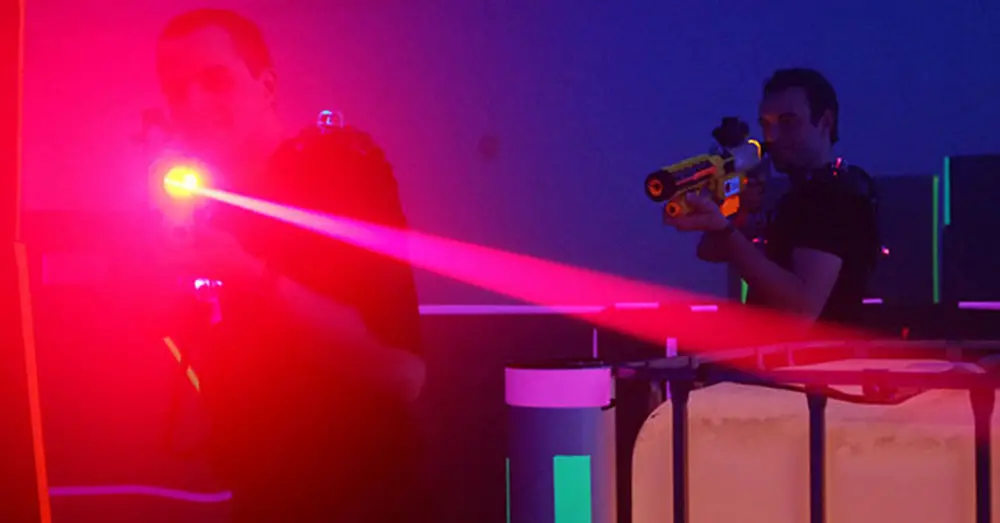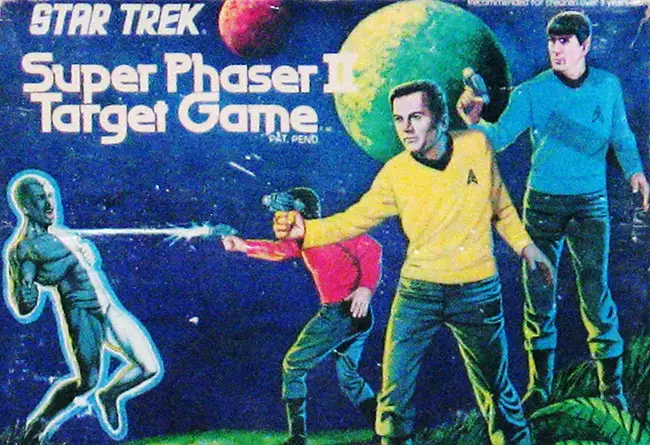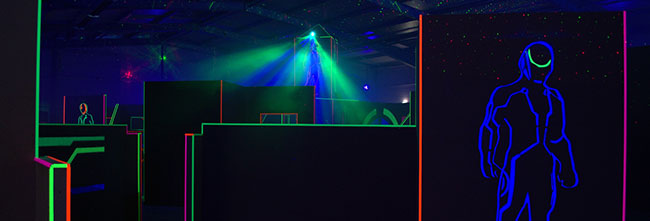Beginners Guide to Laser Tag: History, Technology & More

Chances are you've heard of or even played laser tag before. You might not know all the ins and outs of the game, or where it originated. In this article we are going to cover all aspects of laser tag including the history, technology, common play styles and more. Keep reading for your crash course!
Table of Contents
Introduction
Laser tag players carry gun shaped blasters that fire invisible infrared beams. Sensors register hits when they are tagged by a shot. These sensors are commonly integrated into the gun, a vest worn by the player, a headband, or even into the arena itself.
Since it's introduction in the late 1970's, the game grown to worldwide popularity. Improving technology has brought the game to both indoor and outdoor arenas. Game mechanics have evolved to include combat simulations, role playing games, solo play, team play, competitive events, and a wide range of video game inspired skirmishes.
Compared to sports like paintball or airsoft, the no-contact rules and projectile free play make laser tag accessible for all ages. The harmless infrared beams provide no risk to participants which opens the activity to players of all ages. It is also great exercise because it requires the players to be constantly alert and moving.
The History of Laser Tag
The early days of laser tag begins in the late 1970's and early 80's. Both consumer companies and the military were using the newly introduced infrared transmitter and detector systems to develop products. The developments in both markets eventually led to the modern activity we enjoy today.
Early Consumer Market
Toy companies were producing products inspired by the space-age theme and phasers found in the show. Two product releases are credited as the beginning of modern laser tag. Both toys are now collectibles and can be found online via auction sites like eBay.
Star Trek Super Phaser II Target Game (Mego Corporation, 1976)

This release fell amidst the rush of Star Trek inspired space-age toys. The now defunct Mego Toys produced this simple blaster game which featured a target and gun system. One player would wear the 'target reflector badge'. The other would carry the 'super phaser II gun with sonic buzzer'. In order for more than one person to play, multiple sets would be needed.
The toy was recommended to be used in darker conditions so you could see the light that the blaster emitted. When the target was shot and reflected back, the blaster would activate the sonic buzzer alerting the shooter of a hit. The simple toy was a hit and even made Time's list of All-Time 100 Greatest Toys.
Star Trek Electronic Phaser Guns (South Bend Toy Company, 1979)

The South Bend Toy Company, owned by Milton Bradley, was also in on the Star Trek branded toy rush. South Bend produced the now famous phaser two pack. The blasters were modeled after the Type-2 phaser pistols seen in the Star Trek motion picture.
This box set most closely resembles what modern laser tag came to be. The guns were the first consumer toy product to use infrared detecting technology. A transmitter and sensor were located on the front of the pistol. When a hit was registered the gun would play an explosion sound effect.
Military Development
During the same time period, the US Army deployed a combat training system using infrared technology. The Multiple Integrated Laser Engagement System or MILES "provides tactical engagement simulation for direct fire force-on-force training using eye safe laser 'bullets'". The system saw soldiers carrying infrared enabled weapons which accurately replicated the range and impact of their real life counterparts. Targets were attached to individuals and vehicles used in training operations.

image: 대한민국 국군 Republic of Korea Armed Forces
The program was effective at dramatically increasing the combat readiness and effectiveness of the soldiers who trained with the system. The development also helped the laser tag industry along. Similar systems are still used for training today and manufactured by various companies worldwide.
Modern Industry Progression
Creation of the modern laser tag industry is credited to entrepreneur and inventor George A Carter III. The inspiration for the game came to George in 1977 while watching Star Wars Episode IV. In 1982, George began work to design and create an scored arena-based laser tag game.
The first Photon laser tag center opened in Dallas, Texas in March of 1984. The arena went on to feature multiple locations around the USA. Two years later the first Photon toys were released to the public. The market was quick to fill with similar products by competing companies. These early companies had a short lifespan as the fad was short lived. Photon went out of business in 1989.

Despite the early rise and fall, the laser tag industry settled out and continues today. Laser tag arenas of various brands continue to operate worldwide. Consumer toys are a popular childhood choice, and niche professional grade products are available.
Technology & Types of Equipment
As you can see from the history, the complexity and functions of tag systems vary greatly. From simple low-cost toys to high end military grade systems, you'll find something for any application. The nature of the game puts a heavy reliance technology to create the exciting games and situations for players. The software embedded in the blaster and sensor hardware is responsible for creating engaging game mechanics. Common variables that influence the game commonly include, hit points, number of lives, objective interaction, rate of fire and more.

Equipment falls into 4 main categories:
- Toy Grade
- This category features basic hardware at low costs, most commonly for home use. You'll find colorful blasters with simple features that are easy to use right out of the box. If you're in the market, be sure to have a look at our recommendations for home laser tag kits.
- Business
- Many manufacturers create equipment designed specifically for laser tag business owners. These systems commonly include a blaster + vest combination. Scoring, game type controls, and admin features are included. This allows operators to easily manage games. Quick or wireless charging at the vest stations also helps keep management of games easy.
- Tactical
- This category blurs the lines between toy and business. Most often you'll find high quality products for use both indoor and outdoor. This grade is often used both by individuals who are very into laser tag, or businesses that hold events or rent out equipment. The appearance of these blasters often resembles real weapons. Tactical equipment is perfect for older children and adults.
- Military / Law Enforcement
- Another level of quality beyond tactical, this grade is used for training both the military and law enforcement groups.
Styles of Play
The styles of laser tag play mirror the type of equipment being used. The games rely heavily on the technology of the guns to create the situations and game types. Below we cover the most common styles of play.
Home Laser Tag
Using a home laser tag set, players coordinate a game of their choice in whatever space they have available. This might be in the house, garage, backyard, local park, or a combination. The style of play depends on the features of the blasters. Most home kits either have a small chest mounted sensor or sensors built into the pistols. These designs, especially sensors in the pistols, keeps the toys very simple.
With home games, you'll be running the matches yourself. Be sure to check out our guide on hosting a successful match. With some creativity you can create exciting games!
Commercial Laser Tag

The most common style of laser tag play is at a commercial center. These businesses often feature a dimly lit arena with various obstacles and an interactive environment. Teams enter the arena from a staging area and play a timed game. Each player is linked to a central game computer which manages the game mechanics and player scores.
Blasters at these arenas often include a light beam that shoots from the blasters. In a dark arena environment with a light fog, this allows the beams to be seen. This adds an exciting visual element to the game. These lights have no impact on the scoring system which use infrared light which is invisible to the human eye.
Most commonly, these arenas are often intricately designed to create close combat situations and environment interaction. Sometimes wider open arenas are used that more closely resemble a paintball course. With this style of play, you'll most commonly wear a large vest with multiple sensors attached. Because you have sensors on your front, back, and shoulders the action stays fast paced. Enemies will be able to hit you from all directions so you'll need to keep moving.
Tactical Laser Tag

You'll find outdoor play most commonly uses tactical equipment. The high grade systems feature longer ranges which allows players to engage in many types of games and utilize a large play area. Places like parks and forests can create the best outdoor arenas. Because of this, guns often feature improved sights or even scopes for precise shooting.
Players in a tactical laser tag game will often wear the hit sensors on their head. This positioning keeps the sensors more exposed than on the chest or gun.
In the tactical world are many companies that provide rental equipment and even set up arenas for events. These arenas are often created using sup-air popup obstacles just like paintball. The businesses operating this type of game are fewer than commercial arenas.
Conclusion
This article should give you a good basic introduction into the world of laser tag. If you have any additional questions or comments, please leave them below.
Share this Article:

Leave a Reply